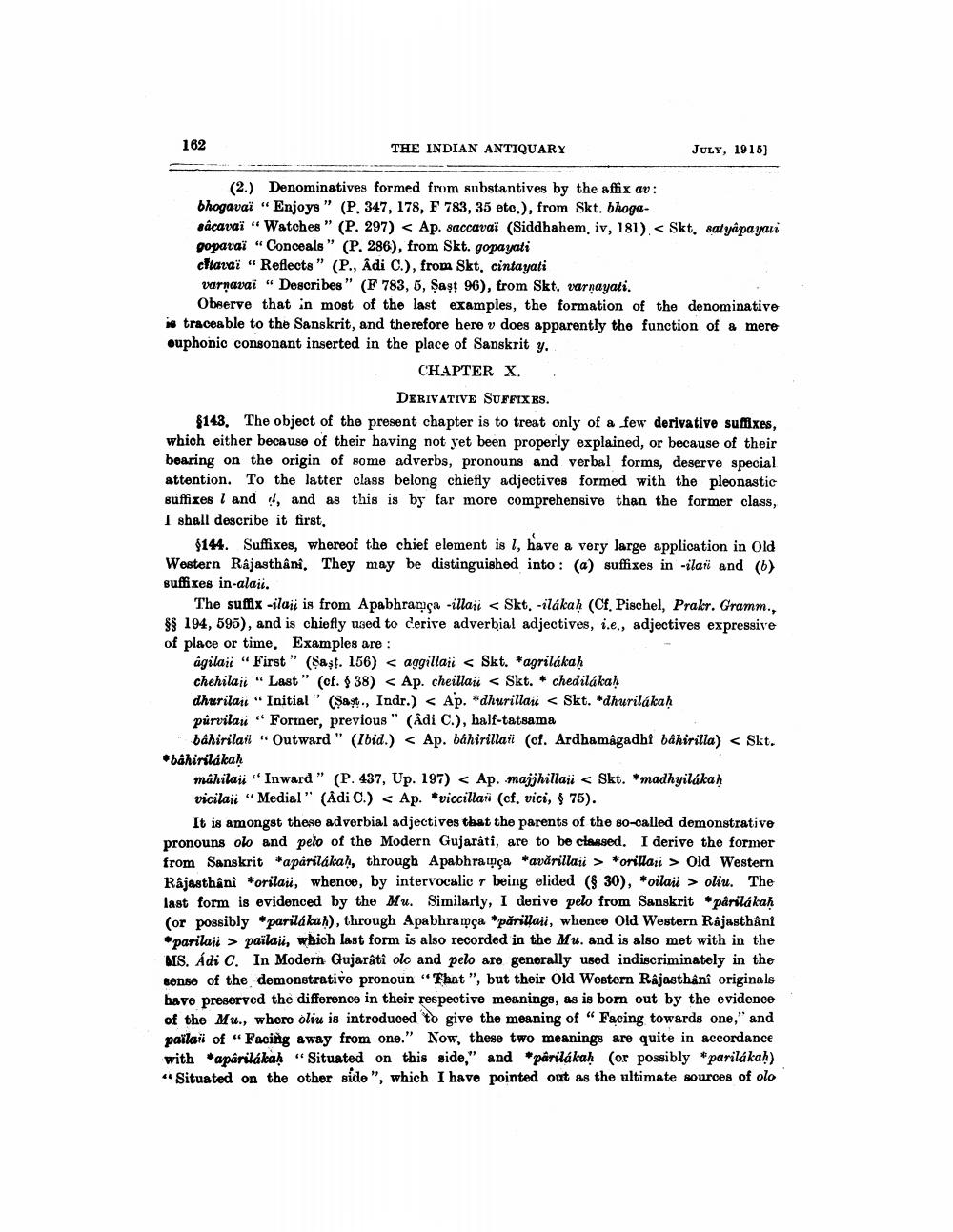________________
162
THE INDIAN ANTIQUARY
JULY, 1915]
(2.) Denominatives formed from substantives by the affix av: bhogavaï "Enjoys" (P. 347, 178, F 783, 35 etc.), from Skt. bhogasâcavaï "Watches" (P. 297) < Ap. saccavaï (Siddhahem, iv, 181).< Skt, satyapayari gopavaï "Conceals" (P. 286), from Skt. gopayati
citava "Reflects" (P., Adi C.), from Skt, cintayati
varnavaï "Describes" (F 783, 5, Sast 96), from Skt. varṇayati.
Observe that in most of the last examples, the formation of the denominative is traceable to the Sanskrit, and therefore here v does apparently the function of a mere euphonic consonant inserted in the place of Sanskrit y.
CHAPTER X.
DERIVATIVE SUFFIXES.
$143. The object of the present chapter is to treat only of a few derivative suffixes, which either because of their having not yet been properly explained, or because of their bearing on the origin of some adverbs, pronouns and verbal forms, deserve special attention. To the latter class belong chiefly adjectives formed with the pleonastic suffixes and, and as this is by far more comprehensive than the former class, I shall describe it first,
$144. Suffixes, whereof the chief element is 7, have a very large application in Old Western Rajasthâni. They may be distinguished into: (a) suffixes in -ila and (b) suffixes in-alaii.
The suffix -ilaii is from Apabhrança -illaii < Skt. -ilákaḥ (Cf. Pischel, Prakr. Gramm., §§ 194, 595), and is chiefly used to derive adverbial adjectives, i.e., adjectives expressive of place or time. Examples are:
agilaii "First" (Sast. 156)
aggillaii < Skt. *agrilákaḥ
chehilai "Last" (cf. § 38) < Ap. cheillai Skt. * chedilákaḥ
dhurilaii "Initial" (Sast., Indr.) < Ap. *dhurillai < Skt. *dhurilákaḥ
pûrvilai "Former, previous" (Adi C.), half-tatsama
bâhirila "Outward" (Ibid.) < Ap. báhirillai (cf. Ardhamâgadhî bâhirilla) < Skt. *bâhirilákaḥ
mahilai "Inward" (P. 437, Up. 197) < Ap. majjhillai < Skt. *madhyilákaḥ vicilaii "Medial" (Adi C.) < Ap. *viccillai (cf. vici, § 75).
It is amongst these adverbial adjectives that the parents of the so-called demonstrative pronouns olo and pelo of the Modern Gujarati, are to be classed. I derive the former from Sanskrit *aparilákaḥ, through Apabhramça *avărillai > *orillaii > Old Western Rajasthânî *orilau, whence, by intervocalic r being elided (§ 30), *oilai oliu. The last form is evidenced by the Mu. Similarly, I derive pelo from Sanskrit *pârilákaḥ (or possibly parilákaḥ), through Apabhramça *parillai, whence Old Western Râjasthânî *parilai pailai, which last form is also recorded in the Mu. and is also met with in the MS. Ádi C. In Modern Gujarati olc and pelo are generally used indiscriminately in the sense of the demonstrative pronoun "That", but their Old Western Rajasthânî originals have preserved the difference in their respective meanings, as is born out by the evidence of the Mu., where oliu is introduced to give the meaning of "Facing towards one," and païla of "Facing away from one." Now, these two meanings are quite in accordance with "aparilákaḥ "Situated on this side," and *parilákaḥ (or possibly *parilákaḥ) "Situated on the other side", which I have pointed out as the ultimate sources of olo




